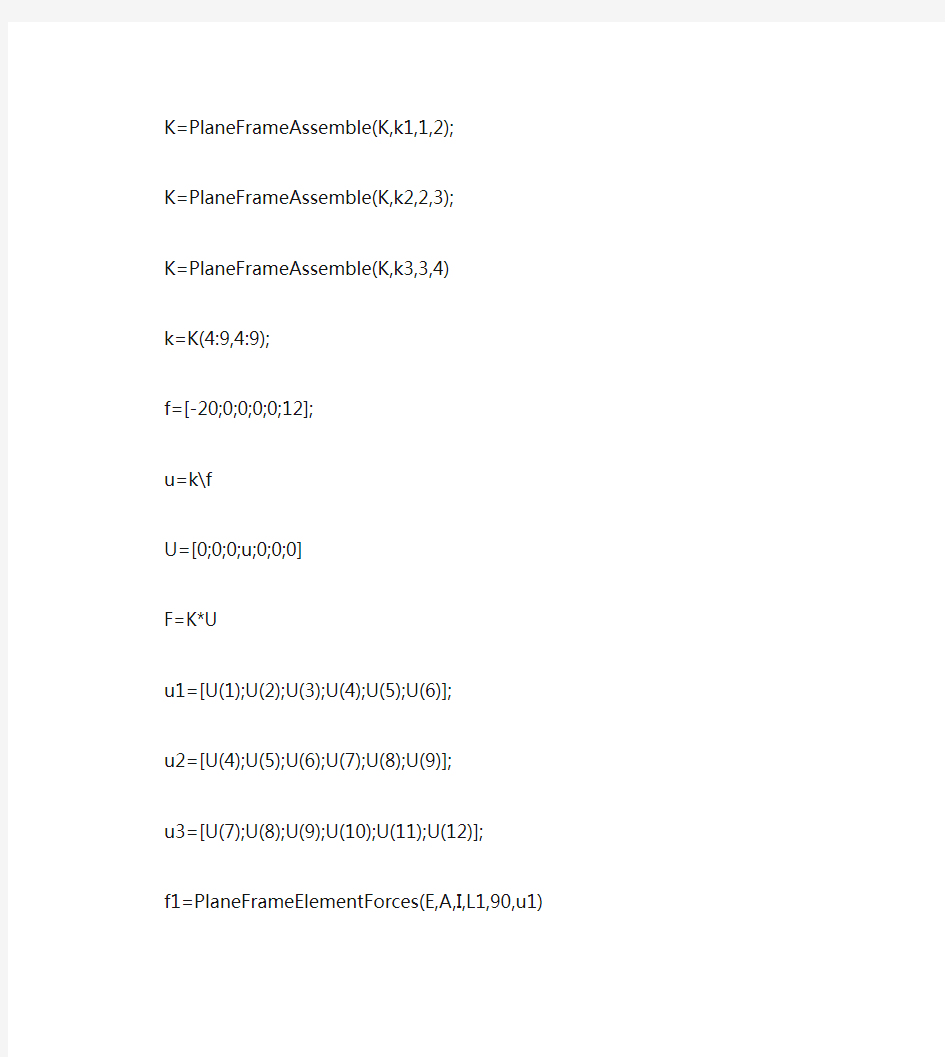

主程序
E=210e6;A=2e-2;I=5e-5;L1=3;L2=4;L3=3;
k1=PlaneFrameElementStiffness(E,A,I,L1,90); k2=PlaneFrameElementStiffness(E,A,I,L2,0);
k3=PlaneFrameElementStiffness(E,A,I,L3,270); K=zeros(12,12);
K=PlaneFrameAssemble(K,k1,1,2);
K=PlaneFrameAssemble(K,k2,2,3);
K=PlaneFrameAssemble(K,k3,3,4)
k=K(4:9,4:9);
f=[-20;0;0;0;0;12];
u=k\f
U=[0;0;0;u;0;0;0]
F=K*U
u1=[U(1);U(2);U(3);U(4);U(5);U(6)];
u2=[U(4);U(5);U(6);U(7);U(8);U(9)];
u3=[U(7);U(8);U(9);U(10);U(11);U(12)];
f1=PlaneFrameElementForces(E,A,I,L1,90,u1)
f2=PlaneFrameElementForces(E,A,I,L2,0,u2)
f3=PlaneFrameElementForces(E,A,I,L3,270,u3)
需调用的函数和子程序
function y=PlaneFrameAssemble(K,k,i,j)
%PlaneFrameAssemble This function assembles the element stiffness
%matrix k of the plane frame element with nodes i and j into the global
%stiffness matrix K .This function returns the global stiffness matrix K after
%the element stiffness matrix k is assembled.
K(3*i-2,3*i-2)=K(3*i-2,3*i-2)+k(1,1);
K(3*i-2,3*i-1)=K(3*i-2,3*i-1)+k(1,2);
K(3*i-2,3*i)=K(3*i-2,3*i)+k(1,3);
K(3*i-2,3*j-2)=K(3*i-2,3*j-2)+k(1,4);
K(3*i-2,3*j-1)=K(3*i-2,3*j-1)+k(1,5);
K(3*i-2,3*j)=K(3*i-2,3*j)+k(1,6);
K(3*i-1,3*i-2)=K(3*i-1,3*i-2)+k(2,1);
K(3*i-1,3*i-1)=K(3*i-1,3*i-1)+k(2,2);
K(3*i-1,3*i)=K(3*i-1,3*i)+k(2,3);
K(3*i-1,3*j-2)=K(3*i-1,3*j-2)+k(2,4);
K(3*i-1,3*j-1)=K(3*i-1,3*j-1)+k(2,5);
K(3*i-1,3*j)=K(3*i-1,3*j)+k(2,6);
K(3*i,3*i-2)=K(3*i,3*i-2)+k(3,1);
K(3*i,3*i-1)=K(3*i,3*i-1)+k(3,2);
K(3*i,3*i)=K(3*i,3*i)+k(3,3);
K(3*i,3*j-2)=K(3*i,3*j-2)+k(3,4);
K(3*i,3*j-1)=K(3*i,3*j-1)+k(3,5);
K(3*i,3*j)=K(3*i,3*j)+k(3,6);
K(3*j-2,3*i-2)=K(3*j-2,3*i-2)+k(4,1);
K(3*j-2,3*i-1)=K(3*j-2,3*i-1)+k(4,2);
K(3*j-2,3*i)=K(3*j-2,3*i)+k(4,3);
K(3*j-2,3*j-2)=K(3*j-2,3*j-2)+k(4,4);
K(3*j-2,3*j-1)=K(3*j-2,3*j-1)+k(4,5);
K(3*j-2,3*j)=K(3*j-2,3*j)+k(4,6);
K(3*j-1,3*i-2)=K(3*j-1,3*i-2)+k(5,1);
K(3*j-1,3*i-1)=K(3*j-1,3*i-1)+k(5,2);
K(3*j-1,3*i)=K(3*j-1,3*i)+k(5,3);
K(3*j-1,3*j-2)=K(3*j-1,3*j-2)+k(5,4);
K(3*j-1,3*j-1)=K(3*j-1,3*j-1)+k(5,5);
K(3*j-1,3*j)=K(3*j-1,3*j)+k(5,6);
K(3*j,3*i-2)=K(3*j,3*i-2)+k(6,1);
K(3*j,3*i-1)=K(3*j,3*i-1)+k(6,2);
K(3*j,3*i)=K(3*j,3*i)+k(6,3);
K(3*j,3*j-2)=K(3*j,3*j-2)+k(6,4);
K(3*j,3*j-1)=K(3*j,3*j-1)+k(6,5);
K(3*j,3*j)=K(3*j,3*j)+k(6,6);
y=K;
function y=PlaneFrameElementForces(E,A,I,L,theta,u)
%PlaneFrameElementforce This function returns the element
% force given the modulus of elasticity
% E,the cross sectional area A,the moment of inetia the length
% L,the angle theta ,and the element nodal
% displacement vector u.
x=theta*pi/180;
C=cos(x);
S=sin(x);
w1=E*A/L;
w2=12*E*I/(L^3);
w3=6*E*I/(L^2);
w4=4*E*I/L;
w5=2*E*I/L;
kprime=[w1 0 0 -w1 0 0;0 w2 w3 0 -w2 w3;0 w3 w4 0 -w3 w5;-w1 0 0 w1 0 0;0 -w2 -w3 0 w2 -w3;0 w3 w5 0 -w3 w4];
T=[C S 0 0 0 0;-S C 0 0 0 0;0 0 1 0 0 0;0 0 0 C S 0;0 0 0 -S C 0;0 0 0 0 0 1];
y=kprime*T*u;
function y=PlaneFrameElementLength(x1,y1,x2,y2)
%PlaneFrameElementLength This function returns the length of the
% plane frame element whose first node % has coordinates(x1,y1)and second nodes has
% coordinates(x2,y2)
y=sqrt((x2-x1)*(x2-x1)+(y2-y1)*(y2-y1));
function y=PlaneFrameElementStiffness(E,A,I,L,theta)
%PlaneFrameElementStiffness This function returns the stiffness matrix of the
% plane frame element with modulus of % elasticity E,cross sectional area A ,length L,moment of inertia and angle theta.
x=theta*pi/180;
C=cos(x);
S=sin(x);
w1=A*C*C+12*I*S*S/(L*L);
w2=A*S*S+12*I*C*C/(L*L);
w3=(A-12*I/(L*L))*C*S;
w4=6*I*S/L;
w5=6*I*C/L;
y=E/L*[w1 w3 -w4 -w1 -w3 -w4;w3 w2 w5 -w3 -w2 w5;-w4 w5 4*I w4 -w5 2*I;-w1 -w3 w4 w1 w3 w4;-w3 -w2 -w5 w3 w2 -w5;-w4 w5 2*I w4 -w5 4*I];